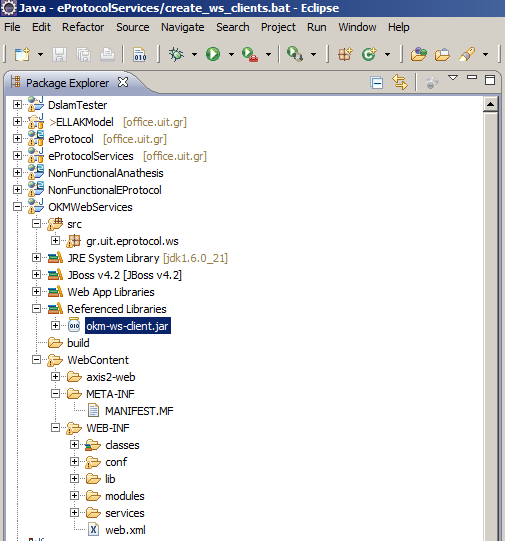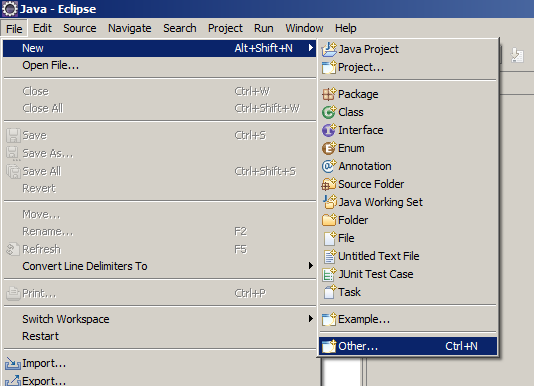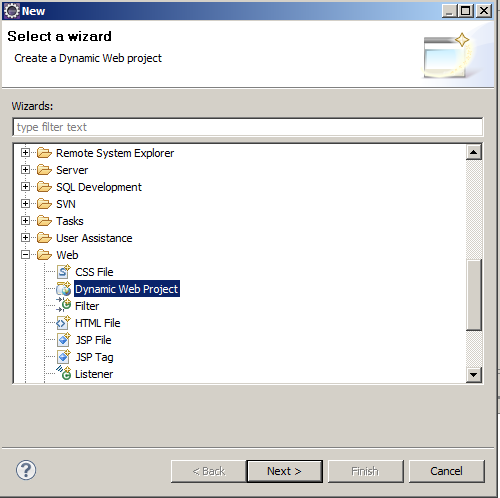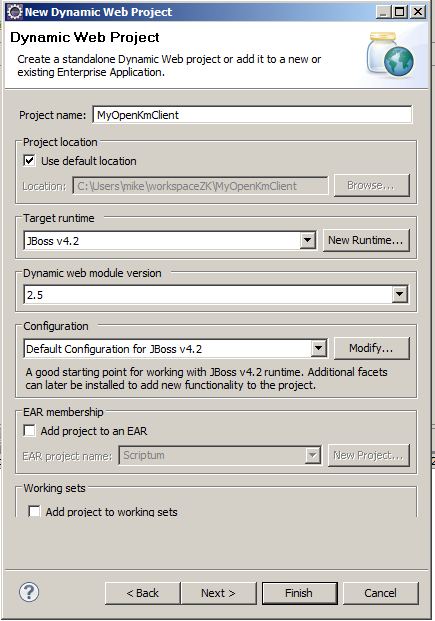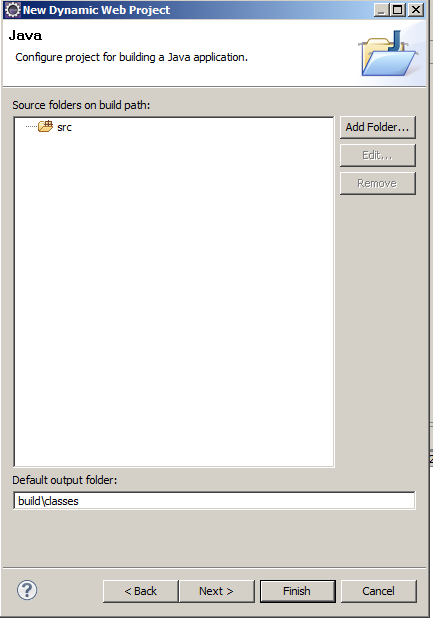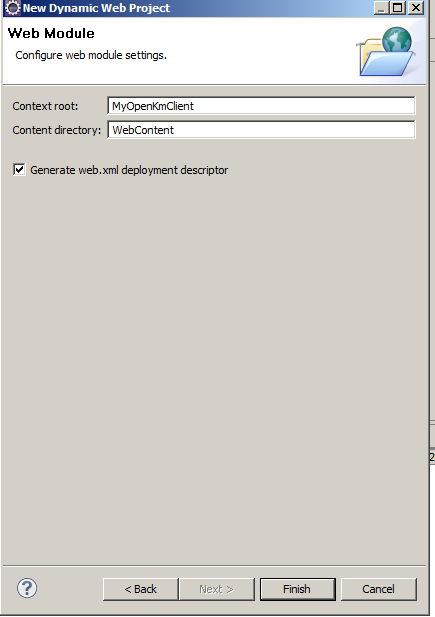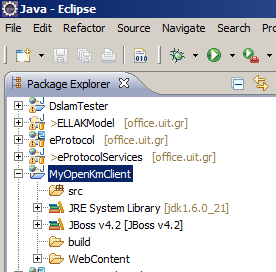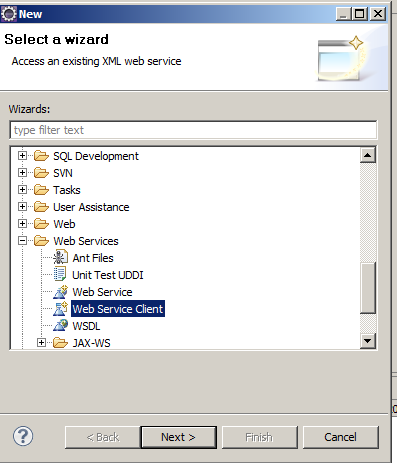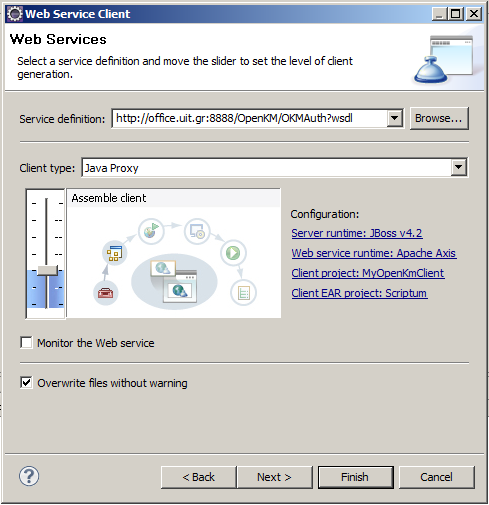Difference between revisions of "User talk:Svaitsis.gss"
(→Implementing a Java Client Web Service to consume OpenKM W/S Using Eclipse Part B) |
|||
| (11 intermediate revisions by the same user not shown) | |||
| Line 43: | Line 43: | ||
[[File:eclipse.png]] | [[File:eclipse.png]] | ||
| − | + | <H1>Implementing a Java Client Web Service to consume OpenKM W/S Using Eclipse Part B </H1> | |
<b>Michael Mountrakis</b><i> Solutions Architect @UIT.GR</i> | <b>Michael Mountrakis</b><i> Solutions Architect @UIT.GR</i> | ||
| Line 60: | Line 60: | ||
| − | Follow the steps of the Dynamic Web Project | + | Follow the steps of the Dynamic Web Project Wizard |
[[File:eclipse_dynamic_web_project2.png]] | [[File:eclipse_dynamic_web_project2.png]] | ||
| − | Follow the steps of the Dynamic Web Project | + | Follow the steps of the Dynamic Web Project Wizard |
# Give your project a name, I named it MyOpenKmClient | # Give your project a name, I named it MyOpenKmClient | ||
| − | # Give your project a | + | # Give your project a run-time. I have chosen the jboss-4.2.3.GA that comes with the OpenKM |
| − | # Give your project a dynamic web module version. For that just | + | # Give your project a dynamic web module version. For that just leave the default 2.5 |
| − | # Don't select EAR | + | # Don't select EAR deployment |
# Click <b>Next</b> | # Click <b>Next</b> | ||
[[File:eclipse_dynamic_web_project3.png]] | [[File:eclipse_dynamic_web_project3.png]] | ||
| + | |||
| + | Click <b>Next</b> | ||
[[File:eclipse_dynamic_web_project4.png]] | [[File:eclipse_dynamic_web_project4.png]] | ||
| + | |||
| + | Select the option <i>Generate web.xml deployment descriptor.</i> | ||
| + | |||
| + | Click <b>Next</b> | ||
[[File:eclipse_dynamic_web_project5.png]] | [[File:eclipse_dynamic_web_project5.png]] | ||
| + | |||
| + | Click <b>Finish</b> to finish the wizard. When wizards finishes, you should have the following project created in your project space: | ||
| + | |||
| + | [[File:eclipse_created_dynamic_web_project.png]] | ||
| + | |||
| + | <b>Step 2</b> Creating the Web Service Client Library inside the Project. | ||
| + | # Click on your project head node in the project's tree view to select the project. | ||
| + | # Right click on the project and from the options New -> Other. From the Wizards menu that appears, select the Web Services -> Web Service Client | ||
| + | # Click Next | ||
| + | |||
| + | [[File:eclipse_select_web_service_client.png]] | ||
| + | |||
| + | Follows the client creation screen | ||
| + | |||
| + | [[File:eclipse_create_web_service_client.png]] | ||
| + | |||
| + | In this screen, put the URL of the OpenKM service you want to implement. For the example, I have used our OpenKM installation at UIT, and the service I need to write a client for is the OKMAuth listening to the following URI: | ||
| + | http://office.uit.gr:8888/OpenKM/OKMAuth?wsdl | ||
| + | |||
| + | The easiest way to test if your OpenKM service is up and listening, is by opening the Mozilla (or any other browser) and put the service's URL: http://localhost:8080/OpenKM/OKMAuth?wsdl or any other URL. (Notice that in UIT's URL we run OpenKM to a different port 8888). Then hit return, and the browser will return you the Web Service's WSDL file: | ||
| + | |||
| + | Also put the Assemble Bar to the Assemble Client level. | ||
| + | |||
| + | Finally, check the Option <i>Overwrite files without warning.</i> | ||
| + | |||
| + | Click <b>Finish</b> to finish the wizard. | ||
| + | When wizards finishes, you should have a new package created inside your project sources: <b>com.openkm.ws.endpoint</b> | ||
| + | |||
| + | Those are the classes to support your client. | ||
| + | |||
| + | <b>Step 3</b> Creating the Web Service Client Class (your code) | ||
| + | |||
| + | # Click on the <b> src </b> of your Project to select it. Right click and from the options select New->Package. Create a package like for example gr.uit.openkm.clients | ||
| + | # Select to the last node of the package (clients) to select it. Right click and from the options select New->Class. Create a new Java Class and call it AuthTester.java. This will be your client implementation. | ||
| + | # Add some simple implementation code: | ||
| + | |||
| + | <pre> | ||
| + | package gr.uit.openkm.clients; | ||
| + | |||
| + | |||
| + | |||
| + | import java.util.logging.Logger; | ||
| + | import com.openkm.ws.endpoint.OKMAuthProxy; | ||
| + | |||
| + | public class AuthTester { | ||
| + | private static Logger logger = Logger.getLogger(AuthTester.class.getName()); | ||
| + | |||
| + | public static void main(String [] argv ){ | ||
| + | OKMAuthProxy authProxy = new OKMAuthProxy(); | ||
| + | authProxy.setEndpoint("http://office.uit.gr:8888/OpenKM/OKMAuth?wsdl"); | ||
| + | try { | ||
| + | String authToken = authProxy.login("mountrakis", "not_gonna_tell_you"); | ||
| + | logger.info("Logged : " + authToken); | ||
| + | |||
| + | } catch (Exception e) { | ||
| + | logger.severe("Error : " + e.getMessage()); | ||
| + | e.printStackTrace(); | ||
| + | } | ||
| + | } | ||
| + | } | ||
| + | </pre> | ||
| + | |||
| + | And get the results: | ||
| + | <pre> | ||
| + | Feb 12, 2011 11:15:01 PM gr.uit.openkm.clients.AuthTester main | ||
| + | INFO: Logged : 83557117735219403024651823084 | ||
| + | </pre> | ||
| + | |||
| + | Method authProxy.setEndpoint() will be used when you need to call the same web service with on a different port, say for example when you will set your client to post to a production site rather than your localhost. | ||
| + | |||
| + | Finally if you see some timeout exceptions do the following things: | ||
| + | # Give a cuple of calls, since JBoss may need to re-cache the service. | ||
| + | # Try to clear the Jboss cash server/default/tmp and restart the server. | ||
| + | |||
| + | Hope you enjoyed. Here is the project's code: | ||
| + | |||
| + | [[Media:MyOpenKmClient.rar]] | ||
| + | |||
| + | == A Singleton Class example for creating the OpenKM Web Service Clients == | ||
| + | |||
| + | <b>Michael Mountrakis</b><i> Solutions Architect @UIT.GR</i> | ||
| + | |||
| + | Hello again. | ||
| + | |||
| + | Moving a simple step ahead, I will indrocude a simple Factory Class that provides a method getInstance() to create your OpenKM web service client proxies to use. The the following class OkmWebServiceClientFactory.java offers getInstance() method. See the code below: | ||
| + | |||
| + | <pre> | ||
| + | |||
| + | import java.util.logging.Logger; | ||
| + | |||
| + | import com.openkm.ws.endpoint.Document; | ||
| + | import com.openkm.ws.endpoint.Folder; | ||
| + | import com.openkm.ws.endpoint.OKMAuthProxy; | ||
| + | import com.openkm.ws.endpoint.OKMDocumentProxy; | ||
| + | import com.openkm.ws.endpoint.OKMFolderProxy; | ||
| + | import com.openkm.ws.endpoint.OKMSearchProxy; | ||
| + | import com.openkm.ws.endpoint.RepositoryException; | ||
| + | import com.openkm.ws.endpoint.QueryResult; | ||
| + | |||
| + | |||
| + | public final class OkmWebServiceClientFactory { | ||
| + | |||
| + | private static Logger logger = Logger.getLogger(OkmWebServiceClientFactory .class.getName()); | ||
| + | |||
| + | public enum ProxyType{ | ||
| + | AUTH, | ||
| + | DOCUMENT, | ||
| + | FOLDER, | ||
| + | SEARCH | ||
| + | } | ||
| + | |||
| + | private OkmWebServiceClientFactoryConfig configuration; | ||
| + | |||
| + | |||
| + | private OkmWebServiceClientFactory(){} | ||
| + | |||
| + | public OkmWebServiceClientFactory( OkmWebServiceClientFactoryConfig config){ | ||
| + | setConfiguration(config); | ||
| + | } | ||
| + | |||
| + | public void setConfiguration( OkmWebServiceClientFactoryConfig configuration){ | ||
| + | this.configuration = configuration; | ||
| + | } | ||
| + | public OkmWebServiceClientFactoryConfig getConfiguration(){ | ||
| + | return this.configuration; | ||
| + | } | ||
| + | |||
| + | /** | ||
| + | * Method to create your proxy object. Call it by passing the appropriate instance type. | ||
| + | * @param pType | ||
| + | * @return The proxy object that must be cast to the appropriate object. | ||
| + | * @throws Exception | ||
| + | */ | ||
| + | |||
| + | public java.rmi.Remote getInstance( ProxyType pType) throws Exception { | ||
| + | |||
| + | switch (pType) { | ||
| + | case AUTH: | ||
| + | OKMAuthProxy authProxy = new OKMAuthProxy(); | ||
| + | if (configuration != null) { | ||
| + | authProxy.setEndpoint(configuration.getOKMAuthPort_address()); | ||
| + | logger.warning("Binding with " | ||
| + | + configuration.getOKMAuthPort_address()); | ||
| + | } | ||
| + | return authProxy; | ||
| + | case DOCUMENT: | ||
| + | OKMDocumentProxy documentProxy = new OKMDocumentProxy(); | ||
| + | if (configuration != null) { | ||
| + | documentProxy.setEndpoint(configuration | ||
| + | .getOKMDocumentPort_address()); | ||
| + | logger.info("Binding with " | ||
| + | + configuration.getOKMDocumentPort_address()); | ||
| + | } | ||
| + | return documentProxy; | ||
| + | case FOLDER: | ||
| + | OKMFolderProxy folderProxy = new OKMFolderProxy(); | ||
| + | if (configuration != null) { | ||
| + | folderProxy.setEndpoint(configuration | ||
| + | .getOKMFolderPort_address()); | ||
| + | logger.warning("Binding with " | ||
| + | + configuration.getOKMFolderPort_address()); | ||
| + | } | ||
| + | return folderProxy; | ||
| + | |||
| + | case SEARCH: | ||
| + | OKMSearchProxy searchProxy = new OKMSearchProxy(); | ||
| + | if (configuration != null) { | ||
| + | searchProxy.setEndpoint(configuration | ||
| + | .getOKMSearchPort_address()); | ||
| + | logger.warning("Binding with " | ||
| + | + configuration.getOKMSearchPort_address()); | ||
| + | } | ||
| + | default: | ||
| + | throw new Exception("You must specify the WS proxy type!"); | ||
| + | } | ||
| + | } | ||
| + | } | ||
| + | </pre> | ||
| + | |||
| + | |||
| + | The configuration object of this class is very trivial. The class OkmWebServiceClientFactoryConfig enhances all configuration parameters like the following code illustrates: | ||
| + | |||
| + | <pre> | ||
| + | public class OkmWebServiceClientFactoryConfig { | ||
| + | private String OKMAuthPort_address = "http://office.uit.gr:8888/OpenKM/OKMAuth"; | ||
| + | private String OKMDocumentPort_address = "http://office.uit.gr:8888/OpenKM/OKMDocument"; | ||
| + | private String OKMFolderPort_address = "http://office.uit.gr:8888/OpenKM/OKMFolder"; | ||
| + | private String OKMSearchPort_address = "http://office.uit.gr:8888/OpenKM/OKMSearch"; | ||
| + | |||
| + | public OkmWebServiceClientFactoryConfig(){} | ||
| + | |||
| + | |||
| + | public String getOKMAuthPort_address() { | ||
| + | return OKMAuthPort_address; | ||
| + | } | ||
| + | public void setOKMAuthPort_address(String oKMAuthPort_address) { | ||
| + | OKMAuthPort_address = oKMAuthPort_address; | ||
| + | } | ||
| + | public String getOKMDocumentPort_address() { | ||
| + | return OKMDocumentPort_address; | ||
| + | } | ||
| + | public void setOKMDocumentPort_address(String oKMDocumentPort_address) { | ||
| + | OKMDocumentPort_address = oKMDocumentPort_address; | ||
| + | } | ||
| + | public String getOKMFolderPort_address() { | ||
| + | return OKMFolderPort_address; | ||
| + | } | ||
| + | public void setOKMFolderPort_address(String oKMFolderPort_address) { | ||
| + | OKMFolderPort_address = oKMFolderPort_address; | ||
| + | } | ||
| + | public String getOKMSearchPort_address() { | ||
| + | return OKMSearchPort_address; | ||
| + | } | ||
| + | public void setOKMSearchPort_address(String oKMSearchPort_address) { | ||
| + | OKMSearchPort_address = oKMSearchPort_address; | ||
| + | } | ||
| + | |||
| + | } | ||
| + | </pre> | ||
| + | Notice that in the previous configuration class we utilize different ports to different Web Service proxies. | ||
| + | This is because in some OpenKM installations we did, we run the Authentication service to a different port than the other web services. | ||
| + | |||
| + | |||
| + | In order to use the previous OkmWebServiceClientFactory class do something like the next code fragment shows: | ||
| + | |||
| + | <pre> | ||
| + | try{ | ||
| + | OkmWebServiceClientFactory factory = new OkmWebServiceClientFactory( new OkmWebServiceClientFactoryConfig() ); | ||
| + | |||
| + | OKMAuthProxy authProxy = (OKMAuthProxy)factory.getInstance(ProxyType.AUTH); | ||
| + | String okmToken = authProxy.login( "mike", "mypass" ); | ||
| + | |||
| + | }catch(Throwable e){ | ||
| + | log.severe("OpenKM Login Error : " + e.getMessage() ); | ||
| + | } | ||
| + | </pre> | ||
Latest revision as of 10:13, 13 February 2011
Implementing a Java Client Web Service to consume OpenKM W/S Using Eclipse Part A
Michael Mountrakis Solutions Architect @UIT.GR
The first part describes how we can compile the WSDL from our OpenKM installation using the wsimport utility that comes with JDK1.6 and above. The produced client library JAR file is then imported in the Eclipse IDE in order to assist our development.
The example starts with a simple MSDOS batch file that generates the client library JAR to support the OpenKM Java Client like the one given in the official Wiki Web Services page
http://wiki.openkm.com/index.php/Java_client
The create_okm_client.bat is the following one:
rem set your javahome and your openKM host set javahome=C:\jdk1.6.0_21 set okmhost=http://office.uit.gr:8888/OpenKM rem ----------------------------------------- echo Creating OpenKM Clients set wsimport=%javahome%\bin\wsimport.exe set jar=%javahome%\bin\jar.exe echo Deleting old clients if exist. del /f okm-ws-client.jar %wsimport% -p com.openkm.ws.client %okmhost%/OKMAuth?wsdl %wsimport% -p com.openkm.ws.client %okmhost%/OKMDocument?wsdl %wsimport% -p com.openkm.ws.client %okmhost%/OKMFolder?wsdl %wsimport% -p com.openkm.ws.client %okmhost%/OKMSearch?wsdl %wsimport% -p com.openkm.ws.client %okmhost%/OKMNotification?wsdl %wsimport% -p com.openkm.ws.client %okmhost%/OKMRepository?wsdl echo Packaging to a jar %jar% cvf okm-ws-client.jar com echo Deleting temporary directory del /f /s /q com
We run the program as a command line in the MS DOS prompt. Uppon successful completion, the file okm-ws-client.jar will be produced.
Next step is to add the okm-ws-client.jar to your Eclipse project:
Implementing a Java Client Web Service to consume OpenKM W/S Using Eclipse Part B
Michael Mountrakis Solutions Architect @UIT.GR
The second part describes how to create a simple OpenKM Client using Eclipse only, without the wsimport utility.
Step 1
Now the first step is to create a new Dynamic Web Project in Eclipse IDE. Select from Left Upper Menu: File -> New -> Other
From the Wizards menu that appears, select the Web->Dynamic Web Project
Follow the steps of the Dynamic Web Project Wizard
Follow the steps of the Dynamic Web Project Wizard
- Give your project a name, I named it MyOpenKmClient
- Give your project a run-time. I have chosen the jboss-4.2.3.GA that comes with the OpenKM
- Give your project a dynamic web module version. For that just leave the default 2.5
- Don't select EAR deployment
- Click Next
Click Next
Select the option Generate web.xml deployment descriptor.
Click Next
Click Finish to finish the wizard. When wizards finishes, you should have the following project created in your project space:
Step 2 Creating the Web Service Client Library inside the Project.
- Click on your project head node in the project's tree view to select the project.
- Right click on the project and from the options New -> Other. From the Wizards menu that appears, select the Web Services -> Web Service Client
- Click Next
Follows the client creation screen
In this screen, put the URL of the OpenKM service you want to implement. For the example, I have used our OpenKM installation at UIT, and the service I need to write a client for is the OKMAuth listening to the following URI: http://office.uit.gr:8888/OpenKM/OKMAuth?wsdl
The easiest way to test if your OpenKM service is up and listening, is by opening the Mozilla (or any other browser) and put the service's URL: http://localhost:8080/OpenKM/OKMAuth?wsdl or any other URL. (Notice that in UIT's URL we run OpenKM to a different port 8888). Then hit return, and the browser will return you the Web Service's WSDL file:
Also put the Assemble Bar to the Assemble Client level.
Finally, check the Option Overwrite files without warning.
Click Finish to finish the wizard. When wizards finishes, you should have a new package created inside your project sources: com.openkm.ws.endpoint
Those are the classes to support your client.
Step 3 Creating the Web Service Client Class (your code)
- Click on the src of your Project to select it. Right click and from the options select New->Package. Create a package like for example gr.uit.openkm.clients
- Select to the last node of the package (clients) to select it. Right click and from the options select New->Class. Create a new Java Class and call it AuthTester.java. This will be your client implementation.
- Add some simple implementation code:
package gr.uit.openkm.clients;
import java.util.logging.Logger;
import com.openkm.ws.endpoint.OKMAuthProxy;
public class AuthTester {
private static Logger logger = Logger.getLogger(AuthTester.class.getName());
public static void main(String [] argv ){
OKMAuthProxy authProxy = new OKMAuthProxy();
authProxy.setEndpoint("http://office.uit.gr:8888/OpenKM/OKMAuth?wsdl");
try {
String authToken = authProxy.login("mountrakis", "not_gonna_tell_you");
logger.info("Logged : " + authToken);
} catch (Exception e) {
logger.severe("Error : " + e.getMessage());
e.printStackTrace();
}
}
}
And get the results:
Feb 12, 2011 11:15:01 PM gr.uit.openkm.clients.AuthTester main INFO: Logged : 83557117735219403024651823084
Method authProxy.setEndpoint() will be used when you need to call the same web service with on a different port, say for example when you will set your client to post to a production site rather than your localhost.
Finally if you see some timeout exceptions do the following things:
- Give a cuple of calls, since JBoss may need to re-cache the service.
- Try to clear the Jboss cash server/default/tmp and restart the server.
Hope you enjoyed. Here is the project's code:
A Singleton Class example for creating the OpenKM Web Service Clients
Michael Mountrakis Solutions Architect @UIT.GR
Hello again.
Moving a simple step ahead, I will indrocude a simple Factory Class that provides a method getInstance() to create your OpenKM web service client proxies to use. The the following class OkmWebServiceClientFactory.java offers getInstance() method. See the code below:
import java.util.logging.Logger;
import com.openkm.ws.endpoint.Document;
import com.openkm.ws.endpoint.Folder;
import com.openkm.ws.endpoint.OKMAuthProxy;
import com.openkm.ws.endpoint.OKMDocumentProxy;
import com.openkm.ws.endpoint.OKMFolderProxy;
import com.openkm.ws.endpoint.OKMSearchProxy;
import com.openkm.ws.endpoint.RepositoryException;
import com.openkm.ws.endpoint.QueryResult;
public final class OkmWebServiceClientFactory {
private static Logger logger = Logger.getLogger(OkmWebServiceClientFactory .class.getName());
public enum ProxyType{
AUTH,
DOCUMENT,
FOLDER,
SEARCH
}
private OkmWebServiceClientFactoryConfig configuration;
private OkmWebServiceClientFactory(){}
public OkmWebServiceClientFactory( OkmWebServiceClientFactoryConfig config){
setConfiguration(config);
}
public void setConfiguration( OkmWebServiceClientFactoryConfig configuration){
this.configuration = configuration;
}
public OkmWebServiceClientFactoryConfig getConfiguration(){
return this.configuration;
}
/**
* Method to create your proxy object. Call it by passing the appropriate instance type.
* @param pType
* @return The proxy object that must be cast to the appropriate object.
* @throws Exception
*/
public java.rmi.Remote getInstance( ProxyType pType) throws Exception {
switch (pType) {
case AUTH:
OKMAuthProxy authProxy = new OKMAuthProxy();
if (configuration != null) {
authProxy.setEndpoint(configuration.getOKMAuthPort_address());
logger.warning("Binding with "
+ configuration.getOKMAuthPort_address());
}
return authProxy;
case DOCUMENT:
OKMDocumentProxy documentProxy = new OKMDocumentProxy();
if (configuration != null) {
documentProxy.setEndpoint(configuration
.getOKMDocumentPort_address());
logger.info("Binding with "
+ configuration.getOKMDocumentPort_address());
}
return documentProxy;
case FOLDER:
OKMFolderProxy folderProxy = new OKMFolderProxy();
if (configuration != null) {
folderProxy.setEndpoint(configuration
.getOKMFolderPort_address());
logger.warning("Binding with "
+ configuration.getOKMFolderPort_address());
}
return folderProxy;
case SEARCH:
OKMSearchProxy searchProxy = new OKMSearchProxy();
if (configuration != null) {
searchProxy.setEndpoint(configuration
.getOKMSearchPort_address());
logger.warning("Binding with "
+ configuration.getOKMSearchPort_address());
}
default:
throw new Exception("You must specify the WS proxy type!");
}
}
}
The configuration object of this class is very trivial. The class OkmWebServiceClientFactoryConfig enhances all configuration parameters like the following code illustrates:
public class OkmWebServiceClientFactoryConfig {
private String OKMAuthPort_address = "http://office.uit.gr:8888/OpenKM/OKMAuth";
private String OKMDocumentPort_address = "http://office.uit.gr:8888/OpenKM/OKMDocument";
private String OKMFolderPort_address = "http://office.uit.gr:8888/OpenKM/OKMFolder";
private String OKMSearchPort_address = "http://office.uit.gr:8888/OpenKM/OKMSearch";
public OkmWebServiceClientFactoryConfig(){}
public String getOKMAuthPort_address() {
return OKMAuthPort_address;
}
public void setOKMAuthPort_address(String oKMAuthPort_address) {
OKMAuthPort_address = oKMAuthPort_address;
}
public String getOKMDocumentPort_address() {
return OKMDocumentPort_address;
}
public void setOKMDocumentPort_address(String oKMDocumentPort_address) {
OKMDocumentPort_address = oKMDocumentPort_address;
}
public String getOKMFolderPort_address() {
return OKMFolderPort_address;
}
public void setOKMFolderPort_address(String oKMFolderPort_address) {
OKMFolderPort_address = oKMFolderPort_address;
}
public String getOKMSearchPort_address() {
return OKMSearchPort_address;
}
public void setOKMSearchPort_address(String oKMSearchPort_address) {
OKMSearchPort_address = oKMSearchPort_address;
}
}
Notice that in the previous configuration class we utilize different ports to different Web Service proxies. This is because in some OpenKM installations we did, we run the Authentication service to a different port than the other web services.
In order to use the previous OkmWebServiceClientFactory class do something like the next code fragment shows:
try{
OkmWebServiceClientFactory factory = new OkmWebServiceClientFactory( new OkmWebServiceClientFactoryConfig() );
OKMAuthProxy authProxy = (OKMAuthProxy)factory.getInstance(ProxyType.AUTH);
String okmToken = authProxy.login( "mike", "mypass" );
}catch(Throwable e){
log.severe("OpenKM Login Error : " + e.getMessage() );
}
